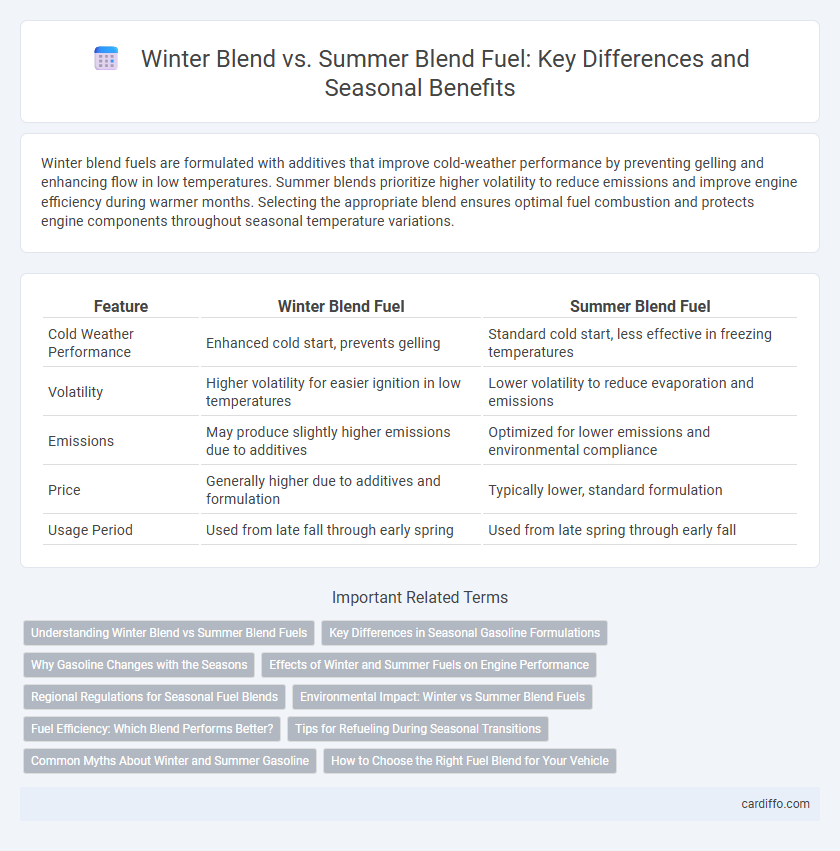Winter blend fuels are formulated with additives that improve cold-weather performance by preventing gelling and enhancing flow in low temperatures. Summer blends prioritize higher volatility to reduce emissions and improve engine efficiency during warmer months. Selecting the appropriate blend ensures optimal fuel combustion and protects engine components throughout seasonal temperature variations.
Table of Comparison
| Feature | Winter Blend Fuel | Summer Blend Fuel |
|---|---|---|
| Cold Weather Performance | Enhanced cold start, prevents gelling | Standard cold start, less effective in freezing temperatures |
| Volatility | Higher volatility for easier ignition in low temperatures | Lower volatility to reduce evaporation and emissions |
| Emissions | May produce slightly higher emissions due to additives | Optimized for lower emissions and environmental compliance |
| Price | Generally higher due to additives and formulation | Typically lower, standard formulation |
| Usage Period | Used from late fall through early spring | Used from late spring through early fall |
Understanding Winter Blend vs Summer Blend Fuels
Winter blend fuels are formulated to prevent fuel gelling and improve engine starting in cold temperatures by incorporating specific additives and lower wax content compared to summer blends. Summer blend fuels prioritize minimizing evaporative emissions and maintaining stability at higher temperatures, reducing vapor lock risks associated with heat. Understanding these seasonal fuel formulations ensures optimal engine performance, fuel efficiency, and emission control throughout the year.
Key Differences in Seasonal Gasoline Formulations
Winter blend gasoline contains higher levels of butane and other volatile compounds to improve cold-start performance and reduce engine issues in low temperatures. Summer blend gasoline features a lower Reid Vapor Pressure (RVP) to minimize evaporation and ozone formation, thereby complying with stricter environmental regulations during warmer months. These seasonal variations optimize fuel efficiency, emissions, and vehicle reliability suited to temperature fluctuations.
Why Gasoline Changes with the Seasons
Gasoline formulations change seasonally to optimize engine performance and reduce emissions under varying temperature conditions. Winter blend fuel contains more volatile compounds to ensure efficient vaporization and easier starting in cold temperatures, while summer blend fuel has a higher boiling point to prevent evaporation losses and smog formation in hot weather. These adjustments help maintain fuel efficiency, minimize air pollution, and meet environmental regulations throughout the year.
Effects of Winter and Summer Fuels on Engine Performance
Winter blend fuels contain additives and higher volatility components that improve cold-start performance and reduce engine wear in low temperatures. Summer blend fuels are formulated with lower volatility to prevent vapor lock and evaporative emissions, ensuring stable combustion and optimized engine efficiency in warmer conditions. Using the appropriate seasonal fuel blend enhances engine reliability, fuel economy, and emissions control throughout the year.
Regional Regulations for Seasonal Fuel Blends
Regional regulations for seasonal fuel blends mandate different formulations for winter and summer blends to optimize engine performance and reduce emissions under varying temperature conditions. Winter blends typically contain higher volatility to enhance cold-start capabilities and prevent fuel line freezing, complying with stricter vapor pressure limits in colder climates. Summer blends are regulated to minimize evaporative emissions and smog formation, featuring lower Reid Vapor Pressure (RVP) requirements to meet air quality standards during warmer months.
Environmental Impact: Winter vs Summer Blend Fuels
Winter blend fuels contain higher volatility compounds to ensure better engine start and performance in cold temperatures, but this increases evaporative emissions contributing to smog formation and air pollution. Summer blend fuels are formulated with lower volatility to reduce evaporative emissions, decreasing the release of volatile organic compounds (VOCs) and ground-level ozone during warmer months. The environmental impact of winter blends is greater in terms of smog production, while summer blends help mitigate air quality issues by limiting VOC emissions.
Fuel Efficiency: Which Blend Performs Better?
Winter blend fuel contains additives that improve cold weather performance by preventing gelling and enhancing ignition, which can slightly reduce fuel efficiency compared to summer blend fuel. Summer blend fuel is optimized for higher temperatures, offering better combustion efficiency and resulting in improved miles per gallon (MPG) during warmer months. Studies show that summer blends typically provide up to 3-5% better fuel efficiency than winter blends under normal driving conditions.
Tips for Refueling During Seasonal Transitions
Refueling with the appropriate seasonal blend ensures optimal engine performance and fuel efficiency as temperatures change. Winter blend fuel contains additives that prevent gelling and improve cold starts, while summer blend focuses on reducing emissions and vapor pressure. To avoid engine issues, refuel during the transition period with the blend designed for upcoming temperature conditions and maintain a consistent fuel brand to ensure compatibility.
Common Myths About Winter and Summer Gasoline
Winter blend gasoline is often misunderstood as being less efficient, but it is specifically formulated with higher volatility to improve cold-start performance and reduce engine wear in low temperatures. Summer blend fuel contains additives that enhance combustion stability and reduce evaporation emissions, preventing vapor lock and ensuring optimal engine performance in heat. Common myths about these blends include the misconception that winter fuel causes engine flooding or that summer fuel cannot be used year-round, both of which are scientifically unfounded and ignore seasonal regulatory standards designed to balance performance and environmental impact.
How to Choose the Right Fuel Blend for Your Vehicle
Choosing the right fuel blend for your vehicle depends on temperature and engine requirements, with winter blends containing higher volatility for easier cold starts and summer blends formulated for heat stability and improved emissions control. If you live in colder climates, prioritize winter blend fuel during the cold months to prevent fuel gelling and ensure smooth engine performance. Consult your vehicle manufacturer's recommendations and consider regional climate data to select the optimal blend that balances engine efficiency, emissions, and fuel longevity.
Winter Blend vs Summer Blend Infographic

 cardiffo.com
cardiffo.com